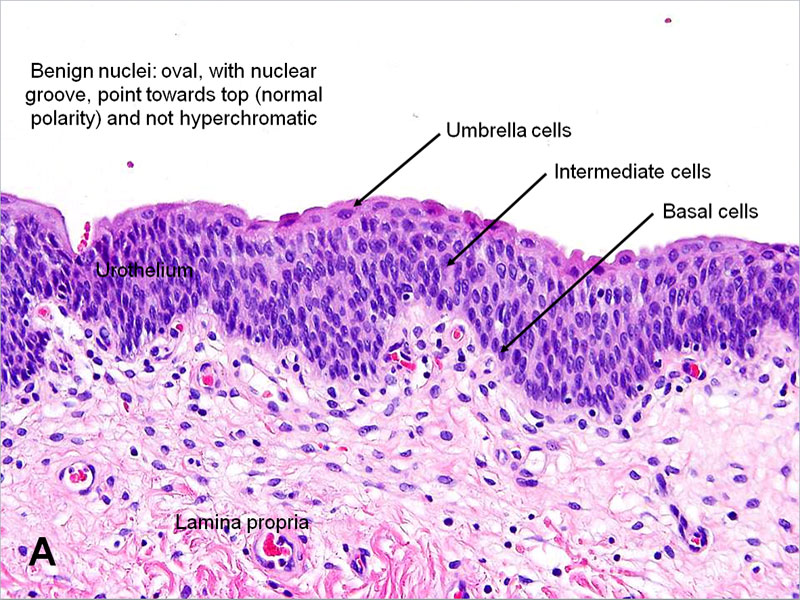[1]
Sellers D, Chess-Williams R, Michel MC. Modulation of lower urinary tract smooth muscle contraction and relaxation by the urothelium. Naunyn-Schmiedeberg's archives of pharmacology. 2018 Jul:391(7):675-694. doi: 10.1007/s00210-018-1510-8. Epub 2018 May 28
[PubMed PMID: 29808232]
[2]
Chai TC, Russo A, Yu S, Lu M. Mucosal signaling in the bladder. Autonomic neuroscience : basic & clinical. 2016 Oct:200():49-56. doi: 10.1016/j.autneu.2015.08.009. Epub 2015 Sep 24
[PubMed PMID: 26422993]
[3]
Andersson KE, Arner A. Urinary bladder contraction and relaxation: physiology and pathophysiology. Physiological reviews. 2004 Jul:84(3):935-86
[PubMed PMID: 15269341]
[4]
Caione P, Capozza N, Zavaglia D, Palombaro G, Boldrini R. In vivo bladder regeneration using small intestinal submucosa: experimental study. Pediatric surgery international. 2006 Jul:22(7):593-9
[PubMed PMID: 16773371]
[5]
Abelson B, Sun D, Que L, Nebel RA, Baker D, Popiel P, Amundsen CL, Chai T, Close C, DiSanto M, Fraser MO, Kielb SJ, Kuchel G, Mueller ER, Palmer MH, Parker-Autry C, Wolfe AJ, Damaser MS. Sex differences in lower urinary tract biology and physiology. Biology of sex differences. 2018 Oct 22:9(1):45. doi: 10.1186/s13293-018-0204-8. Epub 2018 Oct 22
[PubMed PMID: 30343668]
[6]
Walz T, Häner M, Wu XR, Henn C, Engel A, Sun TT, Aebi U. Towards the molecular architecture of the asymmetric unit membrane of the mammalian urinary bladder epithelium: a closed "twisted ribbon" structure. Journal of molecular biology. 1995 May 19:248(5):887-900
[PubMed PMID: 7760330]
[7]
Andersson KE, McCloskey KD. Lamina propria: the functional center of the bladder? Neurourology and urodynamics. 2014 Jan:33(1):9-16. doi: 10.1002/nau.22465. Epub 2013 Jul 11
[PubMed PMID: 23847015]
[8]
Drumm BT, Koh SD, Andersson KE, Ward SM. Calcium signalling in Cajal-like interstitial cells of the lower urinary tract. Nature reviews. Urology. 2014 Oct:11(10):555-64. doi: 10.1038/nrurol.2014.241. Epub 2014 Sep 16
[PubMed PMID: 25224445]
[9]
Sánchez Freire V, Burkhard FC, Schmitz A, Kessler TM, Monastyrskaya K. Structural differences between the bladder dome and trigone revealed by mRNA expression analysis of cold-cut biopsies. BJU international. 2011 Jul:108(2 Pt 2):E126-35. doi: 10.1111/j.1464-410X.2010.09934.x. Epub 2011 Jan 18
[PubMed PMID: 21244608]
[10]
Khandelwal P, Abraham SN, Apodaca G. Cell biology and physiology of the uroepithelium. American journal of physiology. Renal physiology. 2009 Dec:297(6):F1477-501. doi: 10.1152/ajprenal.00327.2009. Epub 2009 Jul 8
[PubMed PMID: 19587142]
[11]
Vannucchi MG, Traini C, Guasti D, Del Popolo G, Faussone-Pellegrini MS. Telocytes subtypes in human urinary bladder. Journal of cellular and molecular medicine. 2014 Oct:18(10):2000-8. doi: 10.1111/jcmm.12375. Epub 2014 Aug 19
[PubMed PMID: 25139461]
[12]
Butros SR, McCarthy CJ, Karaosmanoğlu AD, Shenoy-Bhangle AS, Arellano RS. Feasibility and effectiveness of image-guided percutaneous biopsy of the urinary bladder. Abdominal imaging. 2015 Aug:40(6):1838-42. doi: 10.1007/s00261-015-0356-5. Epub
[PubMed PMID: 25875861]
Level 2 (mid-level) evidence
[13]
Wang G, McKenney JK. Urinary Bladder Pathology: World Health Organization Classification and American Joint Committee on Cancer Staging Update. Archives of pathology & laboratory medicine. 2019 May:143(5):571-577. doi: 10.5858/arpa.2017-0539-RA. Epub 2018 Jul 25
[PubMed PMID: 30044124]
[14]
Jhang JF, Ho HC, Jiang YH, Lee CL, Hsu YH, Kuo HC. Electron microscopic characteristics of interstitial cystitis/bladder pain syndrome and their association with clinical condition. PloS one. 2018:13(6):e0198816. doi: 10.1371/journal.pone.0198816. Epub 2018 Jun 7
[PubMed PMID: 29879217]
[15]
Hodges KB, Lopez-Beltran A, Maclennan GT, Montironi R, Cheng L. Urothelial lesions with inverted growth patterns: histogenesis, molecular genetic findings, differential diagnosis and clinical management. BJU international. 2011 Feb:107(4):532-7. doi: 10.1111/j.1464-410X.2010.09853.x. Epub 2010 Nov 23
[PubMed PMID: 21091975]
[16]
Castillo-Martin M, Domingo-Domenech J, Karni-Schmidt O, Matos T, Cordon-Cardo C. Molecular pathways of urothelial development and bladder tumorigenesis. Urologic oncology. 2010 Jul-Aug:28(4):401-8. doi: 10.1016/j.urolonc.2009.04.019. Epub
[PubMed PMID: 20610278]
[17]
Lenis AT, Lec PM, Chamie K, Mshs MD. Bladder Cancer: A Review. JAMA. 2020 Nov 17:324(19):1980-1991. doi: 10.1001/jama.2020.17598. Epub
[PubMed PMID: 33201207]

